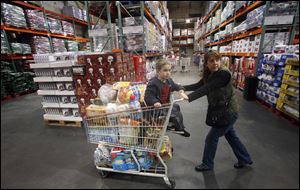
New jobless claims hit 3 1/2-year low
Reports push stocks up slightly
12/16/2011
In Portland, Ore., Tina VanPelt and her son, Soloman, 4, shop at a Costco store. Food and pharmaceutical prices are higher, but energy prices have held steady, keeping inflation in check. And a downward trend in unemployment applications suggests that companies are cutting fewer workers as the economy picks up.
WASHINGTON -- The number of Americans filing new claims for jobless benefits fell to a 3 1/2-year low last week, and factory activity in parts of the Northeast gained speed in December, suggesting a further strengthening of the economic recovery.
While other data on Thursday showed industrial output shrank for the first time in seven months in November, much of the decline came from auto production, which analysts said was held back by temporary supply disruptions.
"It looks like we have just hit a clear patch on the road to recovery, where things are going to speed up a little bit," said Mark Vitner, a senior economist at Wells Fargo Securities in Charlotte.
The fairly upbeat data helped investors on Wall Street put aside their worries about the European debt crisis and buy stocks. U.S. stocks ended slightly higher after three straight days of losses.
The number of people applying for unemployment benefits fell last week to 366,000, the fewest since May, 2008. If the number stayed that low consistently, it likely would signal that hiring is strong enough to lower unemployment.
The unemployment rate for November was 8.6 percent. The last time applications were this low, the rate was 5.4 percent.
The big question is whether fewer layoffs will translate into robust hiring. It hasn't happened yet, even though job growth has increased in recent months.
The four-week average of weekly unemployment applications, which smooths out fluctuations, dropped last week to 387,750. That's the lowest four-week average since July, 2008. The four-week average has declined in 10 of the past 12 weeks.
"Labor market conditions have taken a turn for the better in recent weeks," Michael Gapen, an economist at Barclays Capital, said in a note to clients. "Payroll growth should improve in the coming months."
Separately, the prices companies pay for factory and farm goods rose 0.3 percent last month. The figure was pushed up by higher food and pharmaceutical prices. But energy prices barely rose, keeping inflation in check.
In the 12 months ending in November, wholesale prices have increased 5.7 percent, the Labor Department said Thursday. It's the smallest year-over-year increase since March.
A mixed picture of manufacturing emerged from other reports Thursday. Factory output fell in November for the first time in seven months, according to the Federal Reserve. Manufacturers made fewer cars, electronics, and appliances.
But some economists noted that auto sales rose in November, suggesting that production will rebound.
And the Federal Reserve Banks of Philadelphia and New York said manufacturing expanded in their regions.